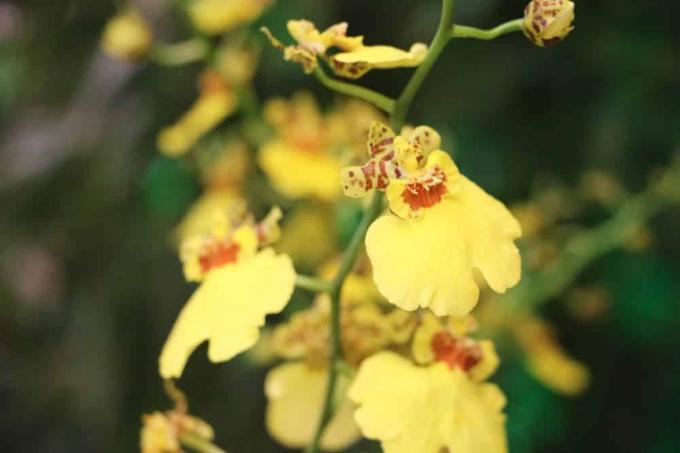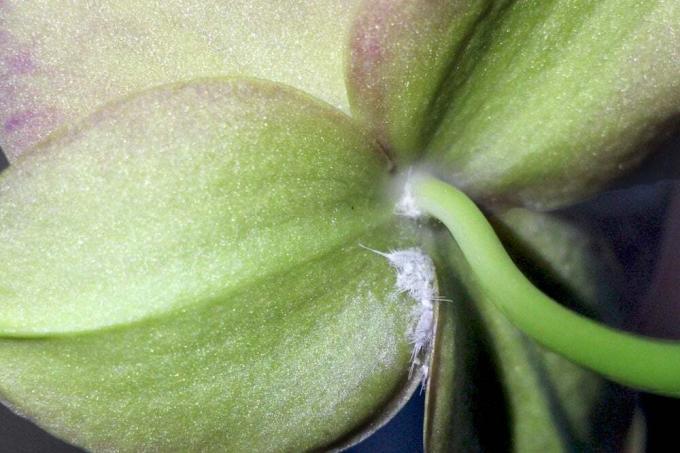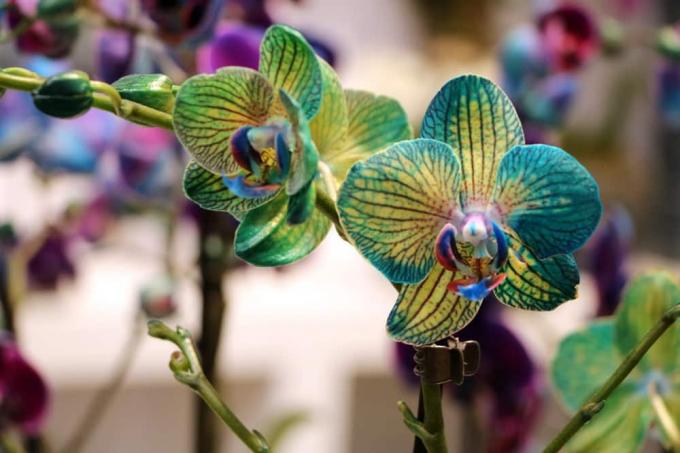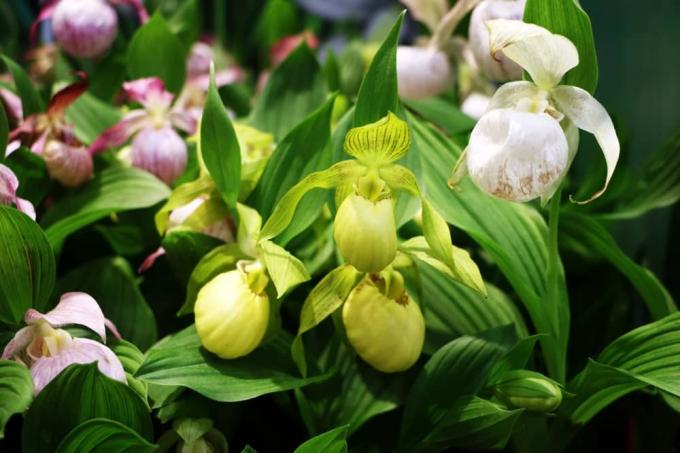

Table of contents
- damage picture
- Important NOTE
- Possible causes
- lack of water
- waterlogging
- lack of light
- High temperature fluctuations
- normal aging process
- Diseases
- pests
- strengthening of the plant
- Prevent
An orchid enchants primarily with its long-lasting, filigree flowers. However, if the leaves of the plant hang down limply or even begin to wither, the overall appearance is disturbed. The orchid does not recover by itself. Courageous intervention is necessary for her to recover quickly. The causes of wilted leaves can be varied, but there are also solutions.
damage picture
Healthy orchid leaves feel smooth and plump, the green has a strong tone. On the other hand, leaves that hang limp and powerless look damaged and diseased. The surface of these leaves can also show folds and wrinkles, and the green color loses its luminosity. the leaves turn yellow at the edges. These are all clear signs that the plant is either diseased or something fundamentally wrong with the care.
Tip:
When buying a new orchid, always pay attention to the appearance of the leaves. They must be plump and bright green. Otherwise, it's best to keep your hands off it.
Important NOTE
First of all: Do not cut off the withered leaves! For one thing, there's a chance you'll get them fit again. On the other hand, germs can penetrate through the open interfaces and damage the already weakened orchid even more. First research possible causes and take appropriate measures. The wilted leaves will either recover over time or eventually dry up completely and can be easily detached by hand.
Possible causes

The possible causes are numerous and the actual cause is not always immediately obvious. So limp leaves could quickly be interpreted as a lack of water and the watering can be reached for. Don't be hasty! Maybe too much water has damaged the roots and made it difficult to absorb water. Therefore, it is best to investigate all possible causes to determine the actual cause of wilted leaves beyond a reasonable doubt. Sometimes a combination of several causes are to blame for the wilted leaves. The possible causes are:
- Lack of water due to insufficient watering
- Root rot from waterlogging
- Lack of light at the current location
- high temperature fluctuations
- normal aging process
- Diseases
- pests
lack of water
If the orchid does not get enough water, all of its vitality suffers. Wilted flowers and saggy leaves are the first signs of this. Buds that have not yet blossomed can also fall off prematurely. The substrate of an orchid must never dry out completely. The orchid must be watered as soon as the substrate has lost a significant amount of moisture, but there is still residual moisture. White or light green roots are a sign of drought.
Take the following immediate measures immediately:
- Immediately immerse the pot in the water for a few minutes.
- Wait for the substrate to soak.
- Be careful not to get water on the leaves.
- Put the plant back on the saucer or in the planter.
- After a few minutes, check whether water has collected in the saucer.
- Discard excess water from the saucer.
Don't be disappointed if this dive doesn't bring any change to the withered leaves. It is very likely that only the new leaves will sprout healthy and strong. In the future, treat the orchid to a new dive as soon as the substrate has noticeably lost moisture. This is the best casting method.
Tip:
If you hold the orchid by the stem and lift it slightly, you will soon get a feel for when it's time to water based on the weight. A freshly watered orchid feels much heavier than one that needs water again.
waterlogging

If the orchid is watered too often and too much, water can collect in the saucer. The orchid quickly reacts to persistent moisture with root rot. Their water absorption is permanently disturbed by rotting roots, while the leaves lose moisture through evaporation at the same time. If the root rot is already very advanced, the orchid can no longer be saved. If only the leaves are wilted and soft, but the shoots are still firm, there is hope that she will survive.
- Immediately remove the plant from the pot.
- Gently shake off the substrate.
- Look closely at the roots: Healthy roots are firm and green. Rotters are mushy and brown.
- With a sharp and clean knife, cut off any rotting roots.
- Remove all flowering shoots, the orchid must focus its energy on root formation.
- Rinse the root ball gently under running water
- Let the plant dry well.
- Plant the plant in new substrate.
- Spray the orchid's aerial roots regularly until new roots have grown in the pot.
Tip:
As a precaution, wear gloves during this rescue operation, some species of orchids are poisonous in parts. Adding algae extracts to the irrigation water can accelerate root formation.
Water less in the future and only when the substrate has clearly lost moisture.
lack of light
Is your orchid in a dark place? If so, a lack of light can cause the orchid to drop all its leaves overnight. Immediately place the orchid in a light spot, but not in direct sunlight. Other large plants that are in the immediate vicinity of the orchid can also take away the light from the smaller orchid. Free the covered orchid from the shade.
High temperature fluctuations

Orchids are sensitive to temperature changes. In winter you must not stand in unheated rooms. Rooms that have different temperatures throughout the day are also not suitable for orchids. In summer, direct sunlight damages you. In this case, look for a new location for your orchid. A window that faces north, west, or east is a good choice. Overwinter your orchid in an evenly warm room, but not directly next to the heater. Cold drafts when airing also damage it.
normal aging process
When the leaves turn yellow and fall off, it's not always a cause for concern. The normal aging process also means that every now and then a leaf dies. As a rule, it is the bottom leaf that dies first due to age. As long as not many leaves turn yellow at the same time, and as long as new leaves sprout, everything is fine.
Especially in autumn and winter, when the orchid needs some rest in its vegetation, individual leaves can dry up and fall off.
Diseases
If a lot of leaves are turning yellow, stem rot is very likely. Bacteria have gotten onto the plant through the irrigation water and cause them to rot right at the base. If water gets into the leaf axils when watering, the disease is encouraged. Unfortunately, any help comes too late for the affected orchid. It now belongs in the trash. Stem rot can be prevented with proper care. An important finding if you own more orchids or want to buy a new orchid.
Prevention is the only solution here. Burn spot disease causes black spots on the leaves, which soon thereafter also turn yellow and wilt. The plant can usually no longer be saved.
pests
Check your orchid for pests such as scale insects. They like to hide on the underside of the leaves and near the roots. The pests suck the liquid out of the leaves. Since they multiply very quickly, the orchid is quickly weakened. Treat the orchid promptly with a suitable agent.
The pest thrips, which looks like a small fly, can be controlled with a pesticide.
Alternatively, the pests can be picked up by hand or drowned in water, submerging the entire plant in water for about 30 minutes.
A notice:
Pests can quickly spread to neighboring plants, so check them for pest infestation as well. Isolate all affected plants from the healthy ones to minimize the risk of infection.
strengthening of the plant

After an illness or weakness caused by poor care, the orchid must be strengthened again. There are some commercially available products that strengthen the leaves and support flowering. In this way, your orchid regains its lost vitality more quickly and becomes more resilient.
Prevent
Prevention is still the best way to prevent wilted leaves on orchids. If the rescue measures for one orchid may be too late, there is still time other orchid specimens through better care and a more suitable location in front of withered leaves maintain. According to the motto "One learns from damage".
 Home editorial office
Home editorial office
Learn more about orchid species

Fight pests on orchids - ways against lice & vermin
Orchids are popular indoor plants and are often given as gifts, but unfortunately they are also occasionally attacked by pests - and these can cause considerable damage to the plants. Interested parties can find out here how pests on orchids can be combated.

Blue orchids: how to dye orchids blue yourself
If orchids with blue flowers are offered in the garden trade, they are usually not natural flower colors. With a bit of skill, you can also dye white-flowering orchids yourself if you repeat the process for each new bloom.

Cypripedium Orchids - Caring for Hardy Lady's Slippers
The exotic plant is a real eye-catcher and, with its unusual flowers, provides the extravagant touch in the home garden. However, if you want to enjoy the beautiful flowers from May, you need a little finesse when it comes to care.

Orchid location above the heating - is heating air harmful?
Many orchid species are native to subtropical and tropical climates. They need light, warmth - and high humidity. Conditions that do not exist in winter and in a place above a heater. With these measures, you can still get your orchids healthy through the cold season.

Native orchids: 8 wild varieties in the garden and forest
No way orchids only thrive in the tropics! They even exist in Antarctica - and of course here too. In fact, a wide range of wild orchid plants can be found in our forests and gardens. Learn more here.

orchid fertilizer vs. Home remedies - which fertilizer is the best?
Orchids are not known as divas among houseplants for nothing, but they are still very popular. They are very demanding when it comes to maintenance. The fertilizer is of particular importance, because the wrong fertilizer can cause a lot of damage.



